Haotian Yang
A Hybrid Force-Position Strategy for Shape Control of Deformable Linear Objects With Graph Attention Networks
Aug 10, 2025Abstract:Manipulating deformable linear objects (DLOs) such as wires and cables is crucial in various applications like electronics assembly and medical surgeries. However, it faces challenges due to DLOs' infinite degrees of freedom, complex nonlinear dynamics, and the underactuated nature of the system. To address these issues, this paper proposes a hybrid force-position strategy for DLO shape control. The framework, combining both force and position representations of DLO, integrates state trajectory planning in the force space and Model Predictive Control (MPC) in the position space. We present a dynamics model with an explicit action encoder, a property extractor and a graph processor based on Graph Attention Networks. The model is used in the MPC to enhance prediction accuracy. Results from both simulations and real-world experiments demonstrate the effectiveness of our approach in achieving efficient and stable shape control of DLOs. Codes and videos are available at https://sites.google.com/view/dlom.
Imbalance in Balance: Online Concept Balancing in Generation Models
Jul 17, 2025Abstract:In visual generation tasks, the responses and combinations of complex concepts often lack stability and are error-prone, which remains an under-explored area. In this paper, we attempt to explore the causal factors for poor concept responses through elaborately designed experiments. We also design a concept-wise equalization loss function (IMBA loss) to address this issue. Our proposed method is online, eliminating the need for offline dataset processing, and requires minimal code changes. In our newly proposed complex concept benchmark Inert-CompBench and two other public test sets, our method significantly enhances the concept response capability of baseline models and yields highly competitive results with only a few codes.
An Empirical Study of the Impact of Federated Learning on Machine Learning Model Accuracy
Mar 27, 2025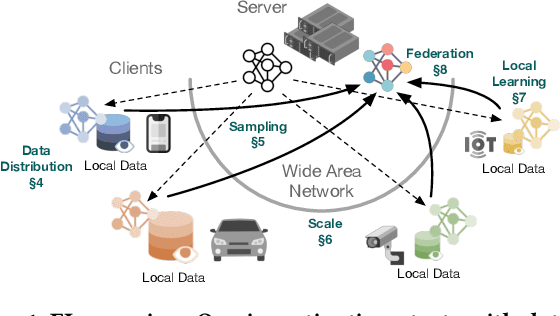
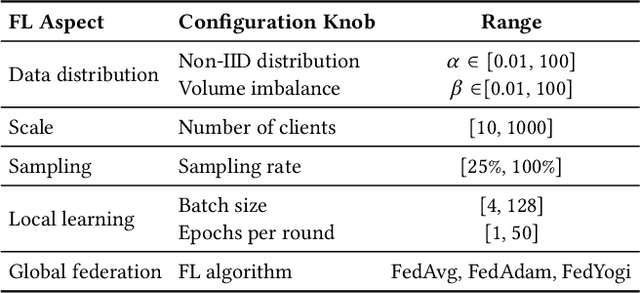

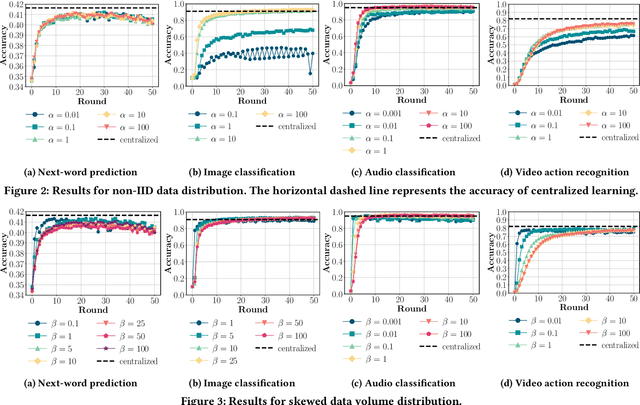
Abstract:Federated Learning (FL) enables distributed ML model training on private user data at the global scale. Despite the potential of FL demonstrated in many domains, an in-depth view of its impact on model accuracy remains unclear. In this paper, we investigate, systematically, how this learning paradigm can affect the accuracy of state-of-the-art ML models for a variety of ML tasks. We present an empirical study that involves various data types: text, image, audio, and video, and FL configuration knobs: data distribution, FL scale, client sampling, and local and global computations. Our experiments are conducted in a unified FL framework to achieve high fidelity, with substantial human efforts and resource investments. Based on the results, we perform a quantitative analysis of the impact of FL, and highlight challenging scenarios where applying FL degrades the accuracy of the model drastically and identify cases where the impact is negligible. The detailed and extensive findings can benefit practical deployments and future development of FL.
DiffMoE: Dynamic Token Selection for Scalable Diffusion Transformers
Mar 18, 2025Abstract:Diffusion models have demonstrated remarkable success in various image generation tasks, but their performance is often limited by the uniform processing of inputs across varying conditions and noise levels. To address this limitation, we propose a novel approach that leverages the inherent heterogeneity of the diffusion process. Our method, DiffMoE, introduces a batch-level global token pool that enables experts to access global token distributions during training, promoting specialized expert behavior. To unleash the full potential of the diffusion process, DiffMoE incorporates a capacity predictor that dynamically allocates computational resources based on noise levels and sample complexity. Through comprehensive evaluation, DiffMoE achieves state-of-the-art performance among diffusion models on ImageNet benchmark, substantially outperforming both dense architectures with 3x activated parameters and existing MoE approaches while maintaining 1x activated parameters. The effectiveness of our approach extends beyond class-conditional generation to more challenging tasks such as text-to-image generation, demonstrating its broad applicability across different diffusion model applications. Project Page: https://shiml20.github.io/DiffMoE/
Koala-36M: A Large-scale Video Dataset Improving Consistency between Fine-grained Conditions and Video Content
Oct 10, 2024Abstract:As visual generation technologies continue to advance, the scale of video datasets has expanded rapidly, and the quality of these datasets is critical to the performance of video generation models. We argue that temporal splitting, detailed captions, and video quality filtering are three key factors that determine dataset quality. However, existing datasets exhibit various limitations in these areas. To address these challenges, we introduce Koala-36M, a large-scale, high-quality video dataset featuring accurate temporal splitting, detailed captions, and superior video quality. The core of our approach lies in improving the consistency between fine-grained conditions and video content. Specifically, we employ a linear classifier on probability distributions to enhance the accuracy of transition detection, ensuring better temporal consistency. We then provide structured captions for the splitted videos, with an average length of 200 words, to improve text-video alignment. Additionally, we develop a Video Training Suitability Score (VTSS) that integrates multiple sub-metrics, allowing us to filter high-quality videos from the original corpus. Finally, we incorporate several metrics into the training process of the generation model, further refining the fine-grained conditions. Our experiments demonstrate the effectiveness of our data processing pipeline and the quality of the proposed Koala-36M dataset. Our dataset and code will be released at https://koala36m.github.io/.
VideoTetris: Towards Compositional Text-to-Video Generation
Jun 06, 2024Abstract:Diffusion models have demonstrated great success in text-to-video (T2V) generation. However, existing methods may face challenges when handling complex (long) video generation scenarios that involve multiple objects or dynamic changes in object numbers. To address these limitations, we propose VideoTetris, a novel framework that enables compositional T2V generation. Specifically, we propose spatio-temporal compositional diffusion to precisely follow complex textual semantics by manipulating and composing the attention maps of denoising networks spatially and temporally. Moreover, we propose an enhanced video data preprocessing to enhance the training data regarding motion dynamics and prompt understanding, equipped with a new reference frame attention mechanism to improve the consistency of auto-regressive video generation. Extensive experiments demonstrate that our VideoTetris achieves impressive qualitative and quantitative results in compositional T2V generation. Code is available at: https://github.com/YangLing0818/VideoTetris
Text-Driven Diverse Facial Texture Generation via Progressive Latent-Space Refinement
Apr 15, 2024



Abstract:Automatic 3D facial texture generation has gained significant interest recently. Existing approaches may not support the traditional physically based rendering pipeline or rely on 3D data captured by Light Stage. Our key contribution is a progressive latent space refinement approach that can bootstrap from 3D Morphable Models (3DMMs)-based texture maps generated from facial images to generate high-quality and diverse PBR textures, including albedo, normal, and roughness. It starts with enhancing Generative Adversarial Networks (GANs) for text-guided and diverse texture generation. To this end, we design a self-supervised paradigm to overcome the reliance on ground truth 3D textures and train the generative model with only entangled texture maps. Besides, we foster mutual enhancement between GANs and Score Distillation Sampling (SDS). SDS boosts GANs with more generative modes, while GANs promote more efficient optimization of SDS. Furthermore, we introduce an edge-aware SDS for multi-view consistent facial structure. Experiments demonstrate that our method outperforms existing 3D texture generation methods regarding photo-realistic quality, diversity, and efficiency.
VRMM: A Volumetric Relightable Morphable Head Model
Feb 06, 2024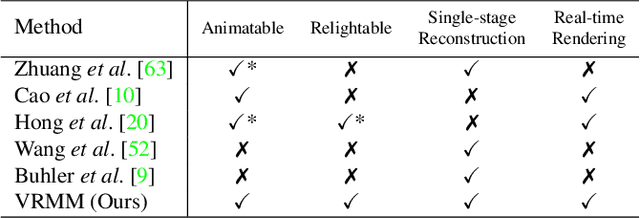
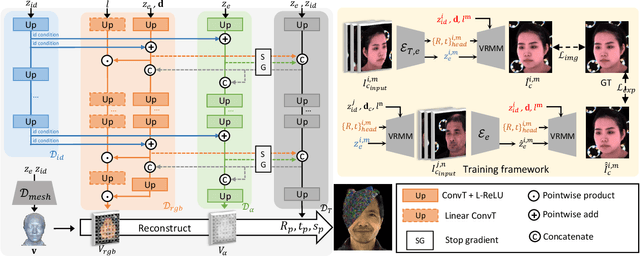

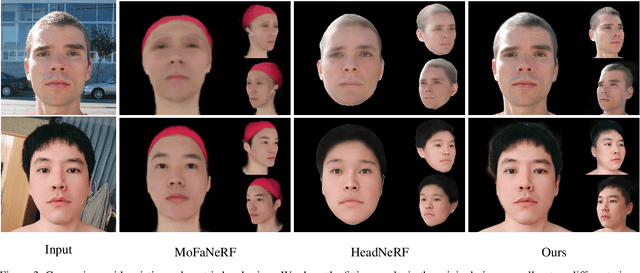
Abstract:In this paper, we introduce the Volumetric Relightable Morphable Model (VRMM), a novel volumetric and parametric facial prior for 3D face modeling. While recent volumetric prior models offer improvements over traditional methods like 3D Morphable Models (3DMMs), they face challenges in model learning and personalized reconstructions. Our VRMM overcomes these by employing a novel training framework that efficiently disentangles and encodes latent spaces of identity, expression, and lighting into low-dimensional representations. This framework, designed with self-supervised learning, significantly reduces the constraints for training data, making it more feasible in practice. The learned VRMM offers relighting capabilities and encompasses a comprehensive range of expressions. We demonstrate the versatility and effectiveness of VRMM through various applications like avatar generation, facial reconstruction, and animation. Additionally, we address the common issue of overfitting in generative volumetric models with a novel prior-preserving personalization framework based on VRMM. Such an approach enables accurate 3D face reconstruction from even a single portrait input. Our experiments showcase the potential of VRMM to significantly enhance the field of 3D face modeling.
Towards Practical Capture of High-Fidelity Relightable Avatars
Sep 08, 2023



Abstract:In this paper, we propose a novel framework, Tracking-free Relightable Avatar (TRAvatar), for capturing and reconstructing high-fidelity 3D avatars. Compared to previous methods, TRAvatar works in a more practical and efficient setting. Specifically, TRAvatar is trained with dynamic image sequences captured in a Light Stage under varying lighting conditions, enabling realistic relighting and real-time animation for avatars in diverse scenes. Additionally, TRAvatar allows for tracking-free avatar capture and obviates the need for accurate surface tracking under varying illumination conditions. Our contributions are two-fold: First, we propose a novel network architecture that explicitly builds on and ensures the satisfaction of the linear nature of lighting. Trained on simple group light captures, TRAvatar can predict the appearance in real-time with a single forward pass, achieving high-quality relighting effects under illuminations of arbitrary environment maps. Second, we jointly optimize the facial geometry and relightable appearance from scratch based on image sequences, where the tracking is implicitly learned. This tracking-free approach brings robustness for establishing temporal correspondences between frames under different lighting conditions. Extensive qualitative and quantitative experiments demonstrate that our framework achieves superior performance for photorealistic avatar animation and relighting.
Detailed Facial Geometry Recovery from Multi-view Images by Learning an Implicit Function
Jan 04, 2022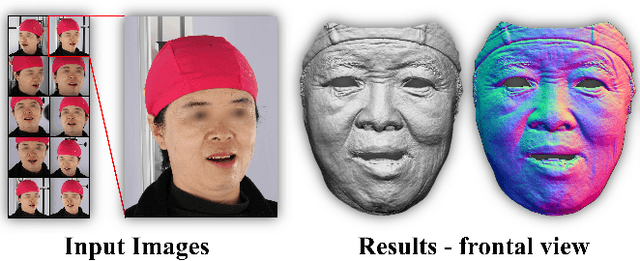
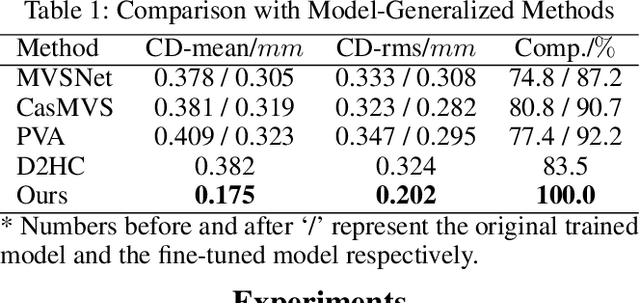

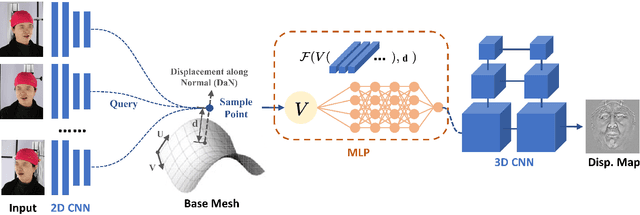
Abstract:Recovering detailed facial geometry from a set of calibrated multi-view images is valuable for its wide range of applications. Traditional multi-view stereo (MVS) methods adopt optimization methods to regularize the matching cost. Recently, learning-based methods integrate all these into an end-to-end neural network and show superiority of efficiency. In this paper, we propose a novel architecture to recover extremely detailed 3D faces in roughly 10 seconds. Unlike previous learning-based methods that regularize the cost volume via 3D CNN, we propose to learn an implicit function for regressing the matching cost. By fitting a 3D morphable model from multi-view images, the features of multiple images are extracted and aggregated in the mesh-attached UV space, which makes the implicit function more effective in recovering detailed facial shape. Our method outperforms SOTA learning-based MVS in accuracy by a large margin on the FaceScape dataset. The code and data will be released soon.
 Add to Chrome
Add to Chrome Add to Firefox
Add to Firefox Add to Edge
Add to Edge